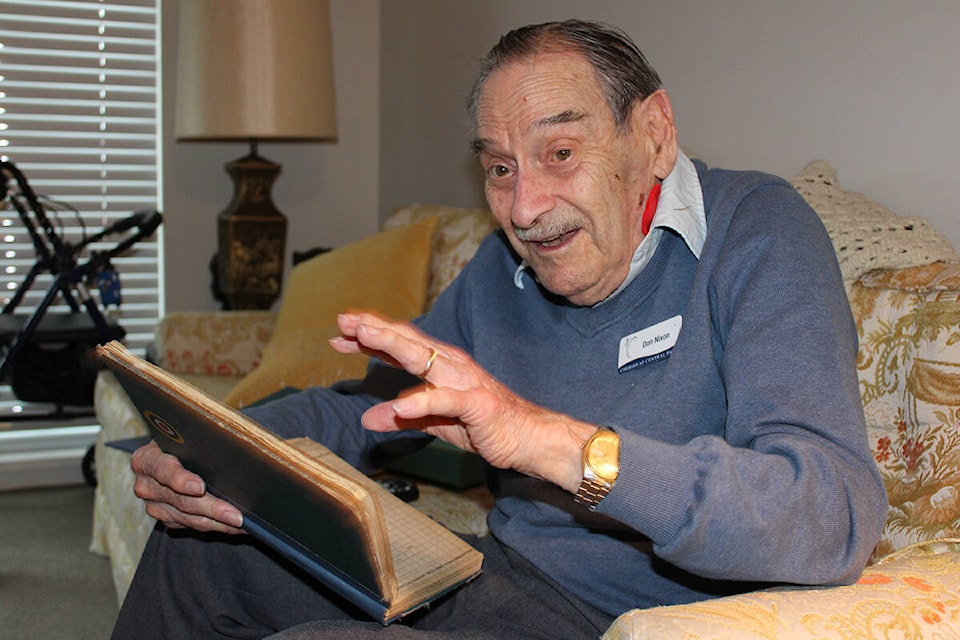At 30,000 feet over Holland, exploding anti-aircraft shells form a deathly curtain as a Halifax bomber aircraft banks just beyond their reach and cuts back the other way, narrowly escaping another wall of fire on its other side.
The zigzag manoeuvre is about as close of a call as it gets, but for Donovan Nixon, the run is emblematic of every one he made during the Second World War.
“I don’t feel I’ve done anything spectacular,” the now 99-year-old said from his Langford retirement home.
In 1942, a 19-year-old Nixon joined the Royal Canadian Air Force because, well, his friends were, so he thought he better too. After going through his pilot training, Nixon’s first assignment was flying over the North Atlantic, patrolling for enemy submarines and aircraft.
“For months, I never saw an enemy sub and maybe that was good, maybe I made sure they were always under the water.”
In early 1943, England was short bomber pilots and he got transferred there. Once trained on the four-engine Halifax planes, which each carried 16 500-pound bombs, he began flying missions mainly targeting enemy oil refineries or rail centres in Germany, France and Holland. His crew never missed a target, but the missions were anything but easy.
“We had to fight our way to the target and fight our way back again.”
A normal tour would consist of 30 operational trips, but Nixon and his crew flew 35 in ‘43. “I had to go on 35 because they were being shot down too often.”
In his first operational trip, German fighter jets shot one side of the bomber’s tail off, but they just managed to make it back to base. “I said ‘Boy if that’s number one, what’re the next 29 going to be like.’” Two trips later, they got shot up so bad his officers couldn’t believe the aircraft was able to fly home.
Every flight saw him evading anti-aircraft cannons on the ground aimed at his bomber. On night operations, enemy fighters would form what was known as a “perch,” where they would sneak above the bomber before diving down while firing at the plane. At other times they’d come from below, sometimes enemy fighters were just everywhere.
“I was flying along and I thought, we’ll never make it,” Nixon said.
“If I ever got caught I was able to get out of it, I don’t know how I did it.”
Much of the time there was no way to know where the enemy would approach from. Sitting in the flight deck, Nixon would see the bullet tracers speeding by and sometimes he’d see fuel streaming out of the engine tanks. The teenage pilot and his engineer would then have to quickly reroute the fuel to another engine before a spark from the exhaust ignited.
After returning from one flight, there was something rattling in one of his bomber’s wing fuel tanks. Upon removing the tank, they found an unexploded incendiary shell inside.
“It would have blown the wing right off,” Nixon said. “That was really close.”
One night their engine was hit and caught fire as Nixon was dropping their bombs. When his engineer went to turn off that hit engine, he mistakenly turned off a good one on the same side. With only half of his engines running, Nixon somehow managed to get his crew back to England. Another trip saw artillery shrapnel piercing through the armoured windshield in front of Nixon. He managed to pull his goggles down as shreds of glass started to shoot back into his face as he flew.
After the war, Nixon become an artist, drawing images that would then be made into neon signs – a job that earned him some handshakes with President John F. Kennedy and Prime Minister Lester Pearson. But in 1951 the skies came calling again when the RCAF asked him to rejoin. There, his work consisted of flying twin-engine fighter jets, training NORAD pilots and doing intelligence and monitoring flights during the Cold War.
Despite his tales of harrowing close calls, Nixon insists he’s not a hero and instead just hopes future generations will remember how he and his crew, and so many others, risked their lives during all those trips thousands of feet above Europe.
But beyond those days of war, flying was what he was meant to do. “I never thought I could fly, but I said I could do it.” His love for reaching new heights is evident as a smile comes across his face when he relives soaring in the fighter jets.
Taking off, he’d hear the roar of the engine. As he climbed higher, that roar would fade to a whisper as the oxygen thins. And then – once above the clouds – almost silence. It’s there where, even though he’s streaking across the sky, the jet feels still as he looks out at the endless purple, not blue, skies.
“Oh, I loved it. I loved it.”
READ: First poppy presented to West Shore WWII veteran
www.twitter.com
